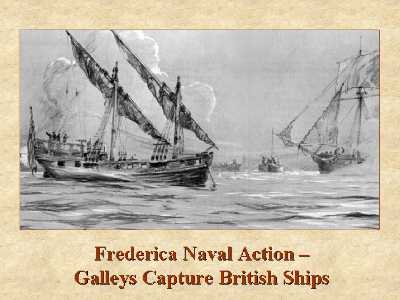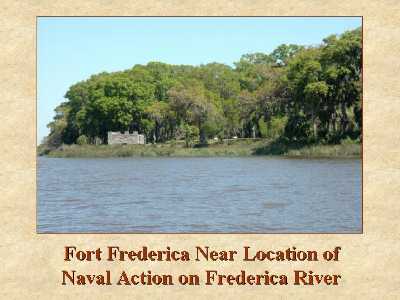|
Engagement Details
Colonel Samuel
Elbert relays news
of the Frederica
Engagement
Georgians in
Frederica Battle
The
Revolutionary
War at Sea
The British Ships
The American Ships
Military Men
Maps of the
Engagement Location
Weapons of the
Period


 |
April 1778 Naval Action near Frederica
at St. Simons Island
Naval Action Brochure
East Florida, who remained loyal
to the British crown during the American Revolution, was separated from
Georgia by the wilderness of forest and swamp lands. In January 1776, the
Continental Congress called upon Georgia and the Carolinas to capture St.
Augustine and sanctioned expeditions against East Florida.
Three routes existed for armed
conflict: an ocean voyage in the Atlantic; the King’s Road connecting Fort
Howe on the Altamaha River and Fort McIntosh on the Satilla River; and the
Inland Passage- coastal rivers and tidal creeks, which was the most
accessible route. In 1776, the Georgia Council of Safety commissioned armed
craft called "galleys" to oppose His Majesty’s ships and the British
privateers operating out of St. Augustine.
The First and Second Florida
Expeditions by the Americans in 1776 and 1777 respectively proved to be
disastrous, primarily due to inadequate planning and lack of coordination
between Georgia's military and civilian authorities. A Third
Florida Expedition was being planned in 1778, when word reached Georgia of
an expected invasion led by British General Augustine Prevost. Colonel
Samuel Elbert, in command of the Georgia Continental Army and Naval forces,
learned in early April of 1778 that the British vessels HMS frigate Galatea, HMS brigantine Hinchinbrook, sloop Rebecca, and brig
Hatter were sailing near St. Simons Sound.
Colonel Elbert detailed about
300 men from the Four Georgia Continental Battalions at Fort Howe to march
to Darien. They embarked at Darien on three Georgia Continental Navy
galleys, Lee, Washington and Bulloch, and with the 50 men of the
First Company of Artillery on board a flat boat, proceeded down the Altamaha
River and its South Branch to the Frederica River. On April 18, 1778, about
100 Georgia Continental troops landed at Pike’s Bluff on St. Simons Island
and marched to Frederica where British prisoners were taken.
The next morning, April 19, the
American forces on board the galleys attacked the British vessels. As
Virginia Steele Wood, Reference Specialist in Naval and Maritime History at the
Library of Congress, describes the naval encounter, "… the wind had died
thereby favoring the Americans and
making it impossible for the British to carry out their plan of sailing
directly into the galleys for boarding. Initially the galleys executed a few
random shots as they rowed toward the enemy, then anchored at a safe
distance of half a mile and began a heavy cannonade, firing right on target
for several hours.
"Since Hinchinbrook’ s
fourteen 4-pounders’ limited range were no match for the galley's 18-, 12-,
and 9-pounders, all three British vessels began dropping downriver. … Believing they
were in a deep channel they resumed moving downstream with the ebb when
suddenly Rebecca grounded in a place the British called "Raccoon
Gut." Almost immediately Hinchinbrook and Hatter suffered the
same fate. Meanwhile the galleys, still firing, were closing fast, by then
about 10 am. Being faced with imprisonment or abandoning ship the British
crowded into their ships’ boats leaving behind some of Hinchinbrook
‘s crew. Six to seven miles distant, the 20-gun HMS Galatea was
awaiting them in St. Simons Sound, and all who escaped made it safely on
board."
The Victory at St. Simons helped
stiffen American resistance at a critical period in Georgia. The Engagement,
which the British called the "Debacle at Raccoon Gut," temporarily left
British East Florida with no naval defenses except the HMS Galetea.
But the Third Florida Expedition ended in 1778 in much the same way as the
previous two. After the capture of Savannah by the British in December 1778
and Sunbury in January 1779, the Revolutionary War had ended on the Inland
Passages in Coastal Georgia and British East Florida.
Frederica Naval
Action (additional details)
Patriots in the sparsely settled Georgia territory between the Altamaha
and St. Marys Rivers were frequently harassed by raiders from British
East Florida, who rounded what cattle they could find, and drove them
back across the St. Marys River. Others pillaged rice and timber or took
slaves from the plantations. In an effort to stop the depredations,
Georgia had attempted unsuccessful military expeditions into East
Florida in 1776 and 1777. The Third Florida Expedition was planned in
l778, when Colonel Samuel Elbert, in command of Georgia Continental Army
and Navy forces, learned that the British vessels, HM frigate Galetea,
HM brigantine Hinchinbrook, sloop Rebecca and an armed watering brig,
were sailing in St. Simons Sound.
For harbor and river defense and to transport troops and supplies.
Colonel Elbert was dependent upon the Georgia Navy galleys, four of
which had been underwritten by the Continental Congress: Lee,
Washington, Bulloch and Congress. All were constructed, launched and
fitted out in Savannah during 1776 and 1777; and were under the command
of Commodore Oliver Bowen. Although no drawings or specifications of the
galleys exist, they were probably like those built by other states with
two masts and triangular sails, and measured approximately seventy-feet
keel, thirteen-feet beam, and four-one-half-feet depth amidships.
On
15 April 1778, when Colonel Elbert learned that four British vessels
were sailing in St. Simons Sound, he detailed about 360 men from the
Four Georgia Continental Battalions at Fort Howe to march toDarien.
There, they embarked on three Georgia Navy galleys: Washington with
Captain John Hardy in command, Lee under Captain John Cutler Braddock
and Bulloch under Captain Archibald Hatcher.
By
mid-afternoon of 18 April, the flotilla entered the Frederica River and
anchored at Pikes Bluff, about a mile and a half above Fort Frederica.
First to land were the troops under the command of Colonel Robert Rae
and Major Daniel Roberts. Colonel Elbert then ordered Captain George
Young and the artillery detachment to land and set up the field piece.
Officers were designated to command troops on board each galley: Colonel
John White on Lee, Captain George Melvin on Washington and Lieutenant
Barnard Patty on Bulloch. Colonel Elbert then directed Colonel Rae with
100 men to march to Fort Frederica where British prisoners were taken.
Other men in Hinchinbrook scouting party escaped by boat and rowed to
Galatea in St. Simons Sound to alert British Captain Jordan, who then
sent a ship loaded with soldiers, to assist Hinchinbrook and Rebecca.
By
the time the intelligence about Hinchinbrook and Rebecca got back to
Colonel Elbert, he deemed it too late in the evening to initiate an
attack. Early the next morning, 19 April, the galleys sailed down the
river to attack the British vessels, which were drawn up in their “order
of battle.” As Virginia Steele Wood, Specialist in Naval and Maritime
History at the Library of Congress, describes the naval action: “It was
probably soon after first light, nearly 5:30am, when Colonel Samuel
Elbert preempted the British and commenced his attack on HM brigantine
Hinchinbrook, the armed sloop Rebecca and
the watering brig. A strong ebb was running in its first quarter, and by
a freak of nature the wind had died thereby favoring the Americans and
making it impossible for the British to carry out their plan of sailing
directly into the galleys for boarding. Initially the galleys executed
a few random shots as they rowed toward the enemy, then anchored at a
safe distance of half a mile and began a heavy cannonade, firing right
on target for several hours.
“Since the limited range of Hinchinbrook’s and Rebecca’s 4-pounders were
no match for the galleys’ heavier ordnance, all three British vessels
began dropping down river. The officers fervently hoped they could find
a place to maneuver and that a breeze would spring up to help them, but
it was not to be. Believing they were in a deep channel they resumed
moving downstream with the ebb when suddenly Rebecca grounded in a place
the British called ‘Raccoon Gut.’ Almost immediately Hinchinbrook and
the watering brig suffered the same fate. Meanwhile the galleys, still
firing, were closing fast, by then about 10 a.m. Being faced with
imprisonment or abandoning ship the British crowded into their ships’
boats leaving behind some of the Hinchinbrook’s crew. Six to seven miles
distant, HM Galatea was awaiting them in St. Simons Sound, and all who
escaped made it safely on board.”
Colonel Elbert sent Brigade Major Joseph Habersham to inform General
Howe of the capture of the British ships. The Frederica Naval Action
was a tremendous boost to Georgians’ morale for it put out of action two
ships that had been interrupting trade by capturing American merchant
vessels off the coast ofSouth Carolina and Georgia. The victory helped
delay for over eight months a major move by the British to capture Fort
Morris and Sunbury. It was also an excellent demonstration of just how
effective heavily armed galleys could be in confined waters when pitted
against blue-water vessels. The tidal currents, lack of wind and
underwater shoals certainly affected the outcome, but credit must be
given to Colonel Samuel Elbert for his courage, his tactics, his
determination, the quality of his leadership, and to each of the
officers and men who served under his command.
Prepared by
Bill Ramsaur, Marshes of Glynn Chapter, GASSAR.
|